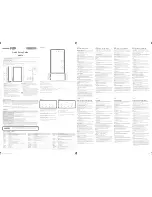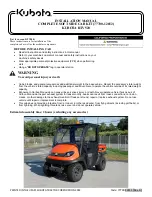
Use extreme caution when rigging this
equipment.
Use this device if your total combined
weight (body, clothing, tools, etc.) exceeds
310 lb.
Use this device when your clearance
distance is a minimum of 2 ft after you
have calculated the total fall distance.
Don’t use this Tripod with more than one
worker at a time.
Plan for a rescue if a worker becomes
unconscious or incapacitated and falls.
Rely on the sound of a closing snaphook.
Visually inspect it to ensure a proper
attachment.
Call FALLTECH at (800) 719-4619 if the
device is damaged or does not function
according to the correct operation
explained in section 1 of this manual.
Use this system if you are pregnant, a
minor, or have reduced tolerance to fall
forces by reason of age, physical or medical
condition, or other pre-existing disorders.
DO NOT USE:
This Device if it has been used as part of a system that has arrested a fall. If it has been used in
such a system, it must be removed from service immediately and sent to an authorized FallTech service location
for inspection and servicing.
5.0 FALL PROTECTION PLAN
As an employer, you must be aware of the factors which affect the safety of your workers before, during and
after a fall. Having a Fall Protection Plan ready before work is the best way to ensure the ultimate safety and
well-being of your employees.
Your Fall Protection Plan must include:
1.
Proper Anchorage: A Properly selected anchorage point is critical to the success of a personal fall arrest
system (PFAS). The anchorage point must be rigid and capable if supporting 5,000 lbs.
2.
Free Fall Limitations: Free fall distance must be taken into consideration when designing a fall protection
system. Potential free falls may not exceed 6 ft. To reduce free fall distance, keep anchorage points above
your working level. Note: ANSI A10.14 requires personal fall arrest systems to be rigged so that the
potential free fall is not greater than 5 ft.
3.
Fall Clearance Distance: Measure the distance between the working level and the next obstruction. Then,
design a system that will not allow a worker to come in contact with the obstruction or next level.
4.
Swing Falls: If a worker is not directly under an anchorage point, a swing fall may result. To minimize this
hazard, evaluate the entire situation, and plan accordingly for a safe clearance distance, or consider a
horizontal lifeline. Contact FALLTECH for assistance.
5.
Rescue and evacuation plan. You must provide a means of rescue and evacuation for workers should a fall
occur.
6.
Immediately dispose of equipment which has been subjected to fall arrest forces.
YOUR CONFINED SPACE ENTRY AND RESCUE PLAN MUST INCLUDE:
1.
Proper Permits (If necessary)
2.
List of Hazards for each entry point.































